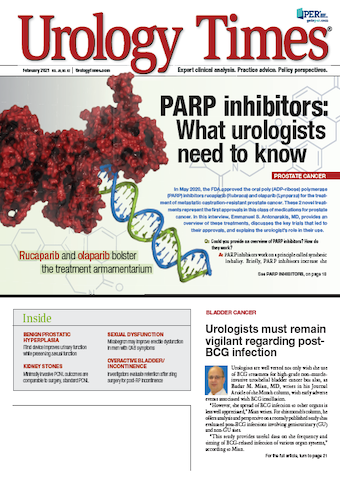Publication
Article
Urology Times Journal
Benefits of robotic approach to simple prostatectomy may outweigh greater cost
Author(s):
Compared with the open procedure, robot-assisted simple prostatectomy was associated with a shorter median hospital stay.
Robot-assisted simple prostatectomy (RASP) is associated with superior perioperative outcomes compared with open simple prostatectomy (OSP). The differences might justify the marginally higher hospitalization cost of RASP and even translate into overall total cost savings, concluded investigators who conducted a comparative analysis of the 2 procedures.1
For the study, investigators used the National Inpatient Sample (NIS) to identify patients who underwent OSP or RASP for benign prostatic hyperplasia (BPH) between 2013 and 2016. It found that compared with the open procedure, RASP was associated with a shorter median hospital stay (2 days vs 4 days), lower overall complication rate (11.1% vs 29.2%), lower rate of blood transfusion (4.3% vs 16.4%), and a greater likelihood of discharge directly to home rather than to a nursing facility (88.9% vs 76.7%; P <.01 for all comparisons).
The investigators also found that complications were associated with increased hospitalization cost and greater length of stay (LOS). Despite the shorter LOS and lower perioperative complication rate associated with RASP, total unadjusted hospitalization cost was significantly greater for RASP compared with OSP ($13,467 vs $10,855), likely related to up-front operative costs. Cost analysis performed with a multivariable regression model that adjusted for relevant patient and hospital characteristics found that the robotic approach to simple prostatectomy contributed an additional $6175 to the cost model, whereas the cost of each additional day of hospital stay contributed $1687, suggesting that a reduction in approximately 3 to 4 hospitalization days needed to offset costs associated with the robot system.
“For patients with BPH who have very large prostate glands, surgical intervention is often necessary to improve quality of life and relieve lower urinary tract symptoms when medical therapy fails, said lead author Raj Bhanvadia, MD, PGY3 urology resident at The University of Texas Southwestern Medical Center, in Dallas. “Among surgical options, there is an increased push towards minimally invasive surgery to minimize morbidity to the patient. However, the risks and benefits of utilization of new surgical technology must be carefully considered. Because cost is not the sole factor to consider in the decision about surgical approach, it is an important consideration in justifying additional expenditures associated with the initial investment and maintenance of the robotic system.”
“We believe that if a man cannot undergo or cannot find a center that offers transurethral surgery for large prostate glands, robotic simple prostatectomy is a viable alternative with clinical advantages compared [with] open surgery with a relatively marginal increase in cost,” Bhanvadia added.
The study included 2551 men in the OSP group and 704 men who had a RASP procedure. A comparison of the characteristics of the 2 cohort results showed that the patients undergoing RASP were significantly younger than the patients undergoing OSP (median age 68 vs 71) and significantly more likely to be obese (11.4% vs 7.2%), and significantly more likely to have no comorbidities (23.2% vs 13.5%). In addition to the differences between the 2 cohorts in rates of overall complications and transfusions, the outcomes analyses showed that RASP was associated with significantly lower rates of respiratory complications, ileus or bowel obstruction, sepsis, and genitourinary complications compared with OSP.
Although other studies have shown that RASP is effective and associated with safety advantages compared with OSP, the comparative analysis conducted by the Southwestern Medical School investigators is one of the first to examine surgical outcomes, length of stay, and cost differences between the 2 procedures in a large US-based population.
“Prior cost studies included a mixed group of approaches, including laparoscopic, had relatively small RASP cohorts, or were single centered and had so far produced mixed results. A major strength of our study relative to others in the literature is that it utilizes a large all-payer national population that includes Medicaid and Medicare patients, with a large number of both OSP and RASP patients included. Additionally, many population-based data sets that could analyze outcomes and costs lack data on all insurance types,” said Bhanvadia.
The investigators acknowledged that major limitations of the comparative analysis were that data were not available for comparing the 2 cohorts with respect to prostate gland size. However, the investigators were unable to break down fixed and variable costs, including operative time and the retrospective nature of the study.
But according to Bhanvadia, perhaps its most important limitation is that it does not compare RASP with holmium laser enucleation of the prostate (HoLEP). “Some studies report advantages of HoLEP compared with RASP, but we were not able to identify HoLEP cases in the NIS due to the limitations of existing Current Procedural Terminology coding,” he said. “Additional studies are needed to provide high-quality comparisons between experienced high-volume robotic centers and high-volume centers specializing in HoLEP.”
Reference
1. Bhanvadia R, Ashbrook C, Gahan J, et al. Perioperative outcomes and cost of robotic vs open simple prostatectomy in the modern robotic era: results from the National Inpatient Sample. BJU Int. Published online September 27, 2020. doi:10.1111/bju.15258

Newsletter
Stay current with the latest urology news and practice-changing insights — sign up now for the essential updates every urologist needs.





























